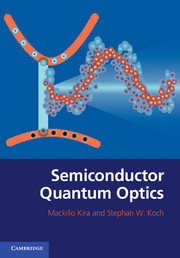Book contents
- Frontmatter
- Contents
- Preface
- 1 Central concepts in classical mechanics
- 2 Central concepts in classical electromagnetism
- 3 Central concepts in quantum mechanics
- 4 Central concepts in stationary quantum theory
- 5 Central concepts in measurement theory
- 6 Wigner's phase-space representation
- 7 Hamiltonian formulation of classical electrodynamics
- 8 System Hamiltonian of classical electrodynamics
- 9 System Hamiltonian in the generalized Coulomb gauge
- 10 Quantization of light and matter
- 11 Quasiparticles in semiconductors
- 12 Band structure of solids
- 13 Interactions in semiconductors
- 14 Generic quantum dynamics
- 15 Cluster-expansion representation of the quantum dynamics
- 16 Simple many-body systems
- 17 Hierarchy problem for dipole systems
- 18 Two-level approximation for optical transitions
- 19 Self-consistent extension of the two-level approach
- 20 Dissipative extension of the two-level approach
- 21 Quantum-optical extension of the two-level approach
- 22 Quantum dynamics of two-level system
- 23 Spectroscopy and quantum-optical correlations
- 24 General aspects of semiconductor optics
- 25 Introductory semiconductor optics
- 26 Maxwell-semiconductor Bloch equations
- 27 Coherent vs. incoherent excitons
- 28 Semiconductor luminescence equations
- 29 Many-body aspects of excitonic luminescence
- 30 Advanced semiconductor quantum optics
- Appendix Conservation laws for the transfer matrix
- Index
- References
7 - Hamiltonian formulation of classical electrodynamics
Published online by Cambridge University Press: 05 January 2012
- Frontmatter
- Contents
- Preface
- 1 Central concepts in classical mechanics
- 2 Central concepts in classical electromagnetism
- 3 Central concepts in quantum mechanics
- 4 Central concepts in stationary quantum theory
- 5 Central concepts in measurement theory
- 6 Wigner's phase-space representation
- 7 Hamiltonian formulation of classical electrodynamics
- 8 System Hamiltonian of classical electrodynamics
- 9 System Hamiltonian in the generalized Coulomb gauge
- 10 Quantization of light and matter
- 11 Quasiparticles in semiconductors
- 12 Band structure of solids
- 13 Interactions in semiconductors
- 14 Generic quantum dynamics
- 15 Cluster-expansion representation of the quantum dynamics
- 16 Simple many-body systems
- 17 Hierarchy problem for dipole systems
- 18 Two-level approximation for optical transitions
- 19 Self-consistent extension of the two-level approach
- 20 Dissipative extension of the two-level approach
- 21 Quantum-optical extension of the two-level approach
- 22 Quantum dynamics of two-level system
- 23 Spectroscopy and quantum-optical correlations
- 24 General aspects of semiconductor optics
- 25 Introductory semiconductor optics
- 26 Maxwell-semiconductor Bloch equations
- 27 Coherent vs. incoherent excitons
- 28 Semiconductor luminescence equations
- 29 Many-body aspects of excitonic luminescence
- 30 Advanced semiconductor quantum optics
- Appendix Conservation laws for the transfer matrix
- Index
- References
Summary
At the conceptual level, the quantization procedure replaces the pure particle description of classical mechanics by a particle-wave treatment satisfying the requirements of the fundamental wave–particle dualism. Technically, one can always start from a generalized wave equation and use it as a basis to discuss wave-front propagation in the form of rays following classical particle trajectories, see Sections 2.2.1 and 3.1. Consequently, any wave theory inherently contains that aspect of the wave–particle dualism.
Especially, Maxwell's equations of electrodynamic theory include both wave and particle aspects of electromagnetic fields. Hence, it could be that there are no additional “quantum,” i.e., wave–particle dualistic aspects. However, as we discuss in this chapter, Maxwell's equations can be expressed in the framework of Hamilton's formulation of particle mechanics. This then suggests that in addition to the approximate ray-like behavior, electromagnetic fields do have a supplementary level of particle-like properties.
Due to the fundamental axiom of wave–particle dualism, the additional particle-like aspects of electromagnetic fields must then also have a wave counterpart that can be axiomatically introduced via the canonical quantization scheme described in Section 3.2.3. Since the spatial dependency in Maxwell's equation contains wave–particle dualism already at the classical level, it is clear that the new level of quantization cannot be a simple real-space feature but has to involve some other space describing the structure of the electromagnetic fields. In fact, this quantization yields several very concrete implications such as quantization of the light energy, elementary fluctuations in the light-field amplitude and intensity, and more.
- Type
- Chapter
- Information
- Semiconductor Quantum Optics , pp. 121 - 140Publisher: Cambridge University PressPrint publication year: 2011

